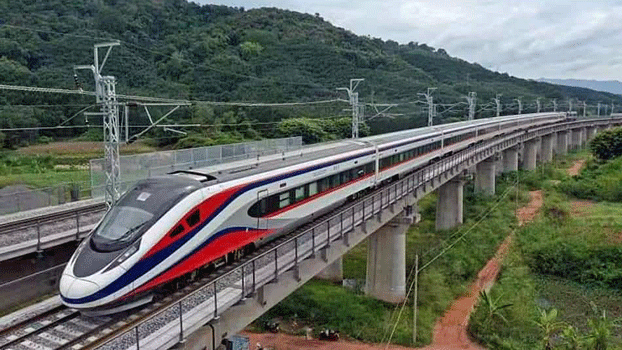
-
Work on a 555-km railway from Vientiane to Vung Ang Port on Vietnam’s coast will begin in November
-
The US$5 billion railway project will give Vientiane access to South China Sea, which plays a vital role in boosting Laotian economic activity
-
Laos is also developing Thanaleng Dry Port and Vientiane Logistics Park, key parts of the Lao Logistics Link initiative to turn the country into an ASEAN logistics hub
A proposed 555-kilometer railway that would link Vietnam to Laos would fuel further Laos’ ambitions to become a regional logistics hub, an investment consulting company says in a report.
In its “ASEAN Briefing” note, Dezan Shira & Associates said the rail project — connecting the Vietnamese port of Vung Ang in Ha Tinh to the Laotian capital Vientiane — will transform landlocked Laos into a land-linked country that can facilitate more trade between its provinces and its Association of Southeast Asian Nations neighbors and turn Laos into a logistics hub.
Construction of the railway, which is estimated to cost US$5 billion, is expected to start in November 2022, the report said. No completion date was announced.
Vung Ang’s deepsea port is the closest feasible port to the Laotian capital. The line would connect with the Laos-China railway, extending the catchment area for freight shipment to Northern Laos and South China.
As the railway will interchange with Vietnam’s North-South railway, the prospect of a Hanoi-Vientiane route is a possibility.
The report said the Laos-China high-speed railway was inaugurated in November 2021, the first of its kind in Southeast Asia that links Vientiane to Boten on the Laos-China border and then runs north to Kunming, the capital of China’s Yunnan province.
Before the 414-km Boten-Vientiane railway was built, Laos had only four kilometers of railway, the report said.
The proposed railway line to Vung Ang gives Vientiane access to the South China Sea, which “plays a vital role in boosting Laotian economic activity through maritime trade and transportation exchanges,” Dezan Shira said.
“The Laos government owns a 60% share in the port, which provides Laos access to the South China Sea, Central Vietnam, Northeast Thailand, and to larger Asian markets, such as South Korea, China, and Japan,” the investment consultancy said.
Vietnam has granted Laos a 50-year concession to use the port, which can accommodate cargo ships of up to 50,000 deadweight tons and container vessels of up to 2,000 twenty-foot equivalents (TEUs), the report said.
This quarter, Laos should complete work on the Thanaleng Dry Port (TDP) and Vientiane Logistics Park (VLP), two mega infrastructures that are part of the Lao Logistics Link initiative to turn the country into a logistics hub in ASEAN.
Built over 300 acres of land, the TDP and VLP will provide freight and cross-border transport services that will be linked to the Laos-China railway and Laos-Vietnam railway.
TDP and VLP, located near the 1st Lao-Thai Mekong Friendship Bridge, are expected to cut transport costs by up to 40% of today’s rates by 2025, and ultimately become an alternative route for ASEAN exporters to the European markets, according to Dezan Shira.
Shipments from Southeast Asia to Europe could take just over 10 days by rail. ASEAN exporters use Singapore as their main transport hub for a voyage to Europe that takes about 45 days, the report said.
State Railway of Thailand plans to increase its freighter services from Laos to Thailand to 24 by 2026, from two round-trips per day today. SRT also plans to develop a 430,000-sq-meter logistics center to be linked to Laemchabang Port.
The report said freight would be transported on the Mekong River into Laos and then on the Laos-China railway.
With only hydropower as its main industry, Laos can harness its rail networks to help transform the country into a regional logistics hub. The rail networks can cut transport costs by up to 40% and are fast becoming the choice of many exporters as fuel prices rise.
A World Bank report said transit trade through Laos could shift an estimated 3.9 million tons by 2030, up from 1.6 million tons recorded in 2016.
“With the higher costs of road, air, and sea cargo shipping, rail transport presents opportunities to enhance Laotian trade with not only China and ASEAN, but potentially with Europe,” the report said.




